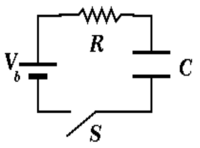Difference between revisions of "Forest RC circuits"
| Line 7: | Line 7: | ||
=Discharging RC circuit= | =Discharging RC circuit= | ||
| − | Let's first describe what happens when a fully charged capacitor is allowed to discharge. Assume we left the battery connected to the above circuit for an infinite amount of time and then | + | Let's first describe what happens when a fully charged capacitor is allowed to discharge. Assume we left the battery connected to the above circuit for an infinite amount of time and then replaced the batteries EMF with a wire so it was no longer working to keep the charge on the capacitor. |
| + | If we apply Kirchhoff's loop Theorem by starting at the location where the battery was go around clockwise we would write | ||
| + | |||
| + | |||
| + | : <math>0 - IR - \frac{q}{C} = 0</math> | ||
=Charging RC circuit = | =Charging RC circuit = | ||
Revision as of 17:05, 3 April 2008
The circuit diagram below defines a common circuit known as an RC circuit. The circuit involves only a capacitor and a resistor. The resistors role is to impede (resist) the flow of current (iR) and the capacitors role is to store charge (q/C).
Pumping air into a bicycle tire is a fair analogy of this circuits properties. You are the battery, the pump you push is the resistor and the tire is the capacitor. As a battery you push electrons through the resistor (pump) and into the capacitor. The resistor (pump) resists the flow of the electrons into the capacitor. As the capacitor starts to charge up (tire fills with air) it becomes harder to push electrons onto the capacitors plates (add air to the tire). Now the capacitor (tire) starts to resist you pumping making it harder to charge up.
Discharging RC circuit
Let's first describe what happens when a fully charged capacitor is allowed to discharge. Assume we left the battery connected to the above circuit for an infinite amount of time and then replaced the batteries EMF with a wire so it was no longer working to keep the charge on the capacitor.
If we apply Kirchhoff's loop Theorem by starting at the location where the battery was go around clockwise we would write
